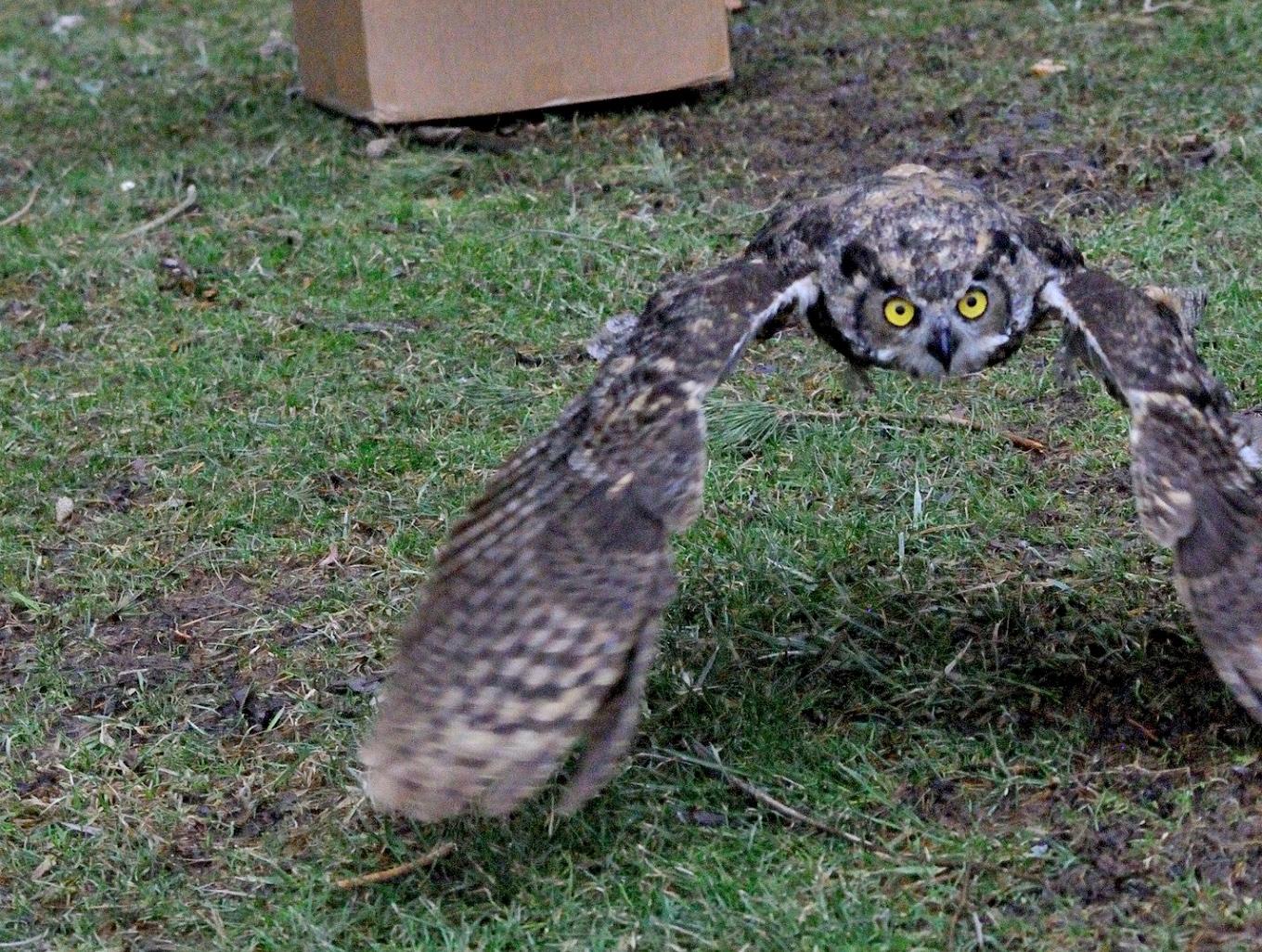Taking flight -- A great horned owl found injured at SUNY Oswego’s Rice Creek Field Station in late November, and rehabilitated at Kindred Kingdoms Wildlife Rehabilitation, was released back at Rice Creek on Jan. 10. (Photo by Mary C. Woods for iHeartOswego.com)
A great horned owl found injured at SUNY Oswego’s Rice Creek Field Station recently completed her comeback story, released back into her wild home on Jan. 10.
Jean Soprano of Kindred Kingdoms Wildlife Rehabilitation took care of the owl for several weeks, but the story receiving a happy ending was not certain when the saga began in late November.
Kristen Haynes, assistant director of Rice Creek Field Station, recalled that Rice Creek Associates, the support group for the nature center, was having a meeting on Nov. 20 when some visitors to the station reported seeing an owl acting unusually. The visitors told Alan Harris, the station’s grounds keeper, that their dog had approached the downed owl, who did not attempt to flee.
“It’s very unusual to see an owl sitting around during the day and acting this way around humans,” Haynes said.
The next day, Rice Creek staff thought the owl had recovered and left, but they saw it again and the bird did not attempt to fly away. “We knew it wasn’t doing very well,” Haynes noted. That’s when she reached out to Soprano.
When Soprano and her husband Len, who have worked together rehabilitating wildlife for 30 years, arrived to take the bird back to their facility, they found the owl “thin, weak and just standing on the ground,” said Soprano.
Path to recovery
“Upon examinations we discovered a deep puncture wound between two toes on her right foot, as well as another deep wound above it on her leg,” said Soprano, a SUNY Oswego alumna whose rehabilitation center in southern Oswego County accepts orphaned and injured black bear cubs, birds of prey, herons, loons, grebes and bats. “My guess was, she had probably been hunting, caught a squirrel, and was bitten by those huge incisor teeth.”
Soprano cleaned the wounds, administered a topical antiseptic and provided fluids to rehydrate the owl. Next they started the owl on an antibiotic, and provided medication to reduce swelling and manage any pain.
An inability to hunt might have contributed to the weight loss, but the owl regained strength as her keepers increased her diet. “Over time both wounds began to heal and she started using that foot again,” said Soprano. “When we felt she was ready, we transferred her to our 176-foot flight cage where she could fly and recondition her flight muscles. After that, we prey tested her with live mice to be sure she could hunt once again. She passed the test with flying colors.”
When Soprano called and said the owl was ready, Haynes was happy to pick the recovered patient up for release and likely an important reunion. “Jean was amazing,” Haynes said.
The owl “took right off, right out of the box,” Haynes recalled. “It’s breeding season for great horned owls. They form long-term pair bonds and may mate for life. For this owl and her mate, that we released her as quickly as possible was very important.”
Mary Woods from community news and events site iHeartOswego was at the initial Rice Creek Associates meeting and has chronicled the bird’s recovery right up to its release, which drew a delighted reaction from the site’s readers. Those involved with the rescue were pleased as well.
“We are thrilled that the release went well,” Soprano said. “I am always so pleased to help out the folks at my own alma mater, SUNY Oswego. We love these happy ending stories.”
Educational experience
While an unfortunate situation, the experience with the owl provided an enlightening encounter with nature for many students, including those in Eric Hellquist’s "Introductory Ecology" class who happened to be at the station around the time of the owl’s discovery.
“To see a nocturnal bird of prey with such ease was an unexpected and exciting detour from our class activities,” said Hellquist, a biological sciences faculty member. “By looking at the owl at such close range we were able to appreciate its body size as well as features such as its talons, eyes, head movements and the ease and grace with which it flew.” Hellquist also asked the students to hypothesize why the bird might be acting unusually.
“One of the values of this experience was its spontaneity and the unusual circumstances that allowed students to see a rather secretive, nocturnal, predatory bird for an extended, uninterrupted period of time,” Hellquist noted. “You don't see owls everyday, and seeing one in this context was exceptional. … When you experience something in person it stays with you, and it changes how you view your surroundings.”
It also underscores the importance of Rice Creek Field Station to future naturalists.
“Seeing the owl also was a reminder of how lucky we are at SUNY Oswego to have a field station that gives our students the opportunity to see something truly unusual,” Hellquist said. “When it comes to studying ecology and the diversity of nature, there is no substitute for the opportunities that proximity provides for experiential learning that can create memories that last a lifetime.”
The public can learn more about owls -- with potential opportunities to see and hear them -- during Rice Creek’s owl prowl events. The upcoming one of Saturday, Feb. 8, is already sold out.
Rice Creek’s five miles of hiking trails are open daily dawn until dusk. Building hours are 9 a.m. to 4:30 p.m. weekdays and 9 a.m. to 3 p.m. Saturdays. Located on nearly 400 acres of mixed terrain accessible from Thompson Road, Rice Creek Field Station has served as a living and working laboratory and educational facility for more than 50 years. For more information, visit oswego.edu/rice-creek or call 315-312-6677.




